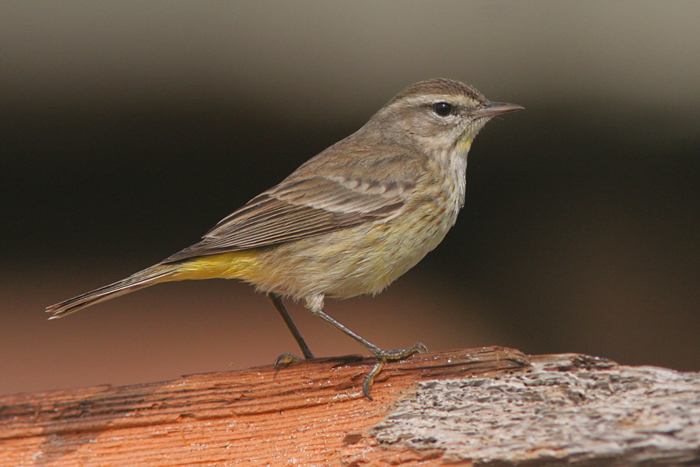
Date: 2003-11-01
Lens: Canon 400mm F5.6

 Palm Warbler
Dendroica palmarum
Palm Warbler
Dendroica palmarum
 Description
DescriptionThis bird consists of two subspecies, the Yellow Palm Warbler in the east and the Western Palm Warbler. Tail wagging, or pumping, is a distinctive feature of Palm Warblers. This bird primarily forages on the ground for insects.
General: 4.5 to 5.5 inches in length. Underparts vary from yellow to whitish-buff, depending on age and geography. Rusty cap and breast streaks may be abscent during non-breeding season.
Western: Grayish-brown upperparts. Whitish-buff underparts with dark breast streaks. Yellow or whitish throat. Adults have rusty caps, which or most obvious on males and sometimes abscent on immature birds. Long, pale supercilium. Bright yellow undertail coverts. Yellowish-olive rump. Dark legs. Thin, pointed bill.
Eastern: Olive brown upperparts. Bright yellow underparts with rusty breast streaks. Adults have rusty caps, which or most obvious on males and sometimes abscent on immature birds. Long, yellow supercilium. Bright yellow undertail coverts. Yellowish-olive rump. Dark legs. Thin, pointed bill.
Northern bogs during summer. Weedy, brushy fields and marsh borders during migration.
 Nesting
Nesting4-5 white eggs with brown speckles. The eggs have a 12 day incubation period. Fledging occurs in 12 days. The nest is made from grass and shreds of bark and lined with feathers and rootlets. The nest is built on the ground, on a grass clump, often at the base of a bush or small tree. Sometimes nests in loose colonies.